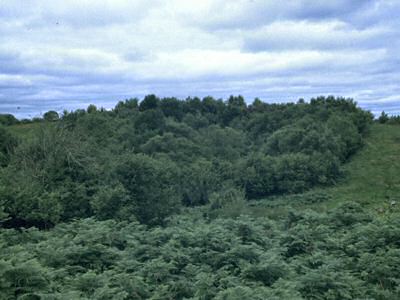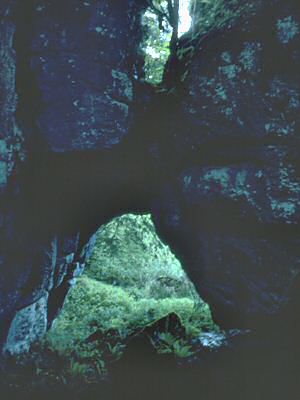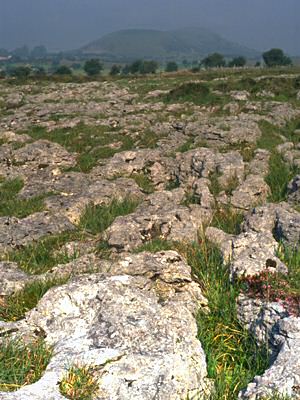Earth Science Conservation Review
| Marlbank-Cuilcagh Mountain Region; Marble Arch Karst | Fermanagh |
| Site Type: | Karst |
| Site Status: | ASSI |
| Council area: | Fermanagh District Council |
| Grid Reference: | H1233 |
| Google maps: | 54.24621,-7.8159 |
| Rocks | |
|---|---|
| Rock Age: | Quaternary, Carboniferous (Asbian, Holocene, Visean) |
| Rock Name: | Dartry Limestone Formation, Glenade Sandstone Formation, Glencar Limestone Formation, Knockmore Limestone Member, Meenymore Formation |
| Rock Type: | Dolerite, Limestone, Mudstone, Shale |
| Interest | |
| Minerals: | Calcite, Dolomite |
| Other interest: | bedding, dyke, fault, joints, rift, blind valley, breakdown, cave, cave pearls, clastic sediments, conulite, dendritic river cave, doline, drift, dry valley, flowstone, gour pool, helictite, karren, limestone pavement, pothole, sinkhole, speleothem, splattermite, stalactite, stalagmite, ste |
Summary of site:
This cave system and the associated karst in its catchment are rightly considered to be one of the finest examples of a mature karst landscape and system in the British Isles. The catchment, at around 27 sq km, is the largest in Northern Ireland. Over 7000m of passageway have been explored and mapped and the volume of water exiting the system varies from 1-1.5 cubic metres per second in ‘normal' circumstances to more than 10 in flood conditions.
The individual components of the system are described separately under their own names, in five groups:- Marble Arch Cave (Key Site 347); the Owenbrean River caves (Key Sites 348, 349); the Aghinrawn River caves (Key Sites 350–352, 361, 362); the Sruh Croppa River caves (Key Sites 353, 355–360, 1083) and other associated caves (Key Sites 354, 363–366). The individual accounts are detailed and explain immediate relationships. The account of Marble Arch Cave describes broader associations, linking the components together.
This overview describes the hydrology (water flow) of the area and the karst features above ground.
The Marble Arch system is fed by three rivers (actually more like substantial upland streams) that drain the north face of Cuilcagh Mountain. East to west these are the Owenbrean, the Aghinrawn and the Sruh Croppa. It is important to know that the Ordnance Survey of Northern Ireland (OSNI) maps have the middle and eastern rivers wrongly marked. Locally the central river flowing to Monastir Cliff (the Owenbrean on OSNI maps) has always been called the Aghinrawn and the eastern river, sinking at Pollasumera (unnamed on the OSNI maps) is the Owenbrean. All other literature adheres to this local usage.
The long established cave system is at least 75,000 years old but is probably much older in part and is dendritic (branching, tree-like, with all tributaries merging into one, forming the Cladagh River that flows from the head of Cladagh Glen in this case). The streams passing through the system flow along the floors of their passages with substantial air space above (a condition described as vadose), except for short periods during rainstorm flood conditions. Very few passages in the system are known to flow below the water table (this permanently flooded condition is described as phreatic). In general, the passages, chambers and potholes have developed along the line of joints (natural, undisturbed fractures that cut the rocks vertically, usually in two sets intersecting at right angles) and faults (fractures along which there has been some movement).
The underground course of the Owenbrean shows this well, with long north-south trending passages and short east-west links. The main stream passage is now the most easterly fed through Pollasumera into Pollnagollum of the Boats; then, after a short impenetrable stretch, it reappears in Skreen Hill 3. It is thought that the sub-parallel streamway to the west, Legnabrocky Way, was the original underground course of the Owenbrean. The surface stream would then have flowed further west until the joints at the infant Pollasumera became sufficiently enlarged to take the river's flow.
In its early development, the Aghinrawn passed underground through caves at a high level; remnants of a few have survived high on Monastir Cliff and in the immediate area but, as the river has progressively cut down to deeper levels, they have been abandoned and left high and dry. Today the river flows through what is believed to be a largely phreatic section, unexplored and possibly impenetrable, of passage called Monastir Way; it emerges in Upper Cradle Hole en route through Lower Cradle and Grand Gallery to merge with the Owenbrean at the Junction in the Marble Arch show cave.
The Sruh Croppa shows yet another hydrological style, sinking into its bed in a variety of places depending on the volume of flow. Passages below stream level are also mostly dry and it seems likely that there are phreatic levels a little deeper. The dry passages become active in spate conditions but only at times of severe flood does the surface stream fill and continue to Cat's Hole and beyond. The stream reappears in Pollthanarees and thence to Mastodon, merging with the Aghinrawn on the far side of a phreatic section, 400m long, in Lower Cradle.
The Owenbrean previously flowed through New Chamber, via a sump, to Pool Chamber and the Junction, but a lower level river capture now takes the flow on an almost direct line. All this section can be seen in the show cave. The sump between New Chamber and Pool Chamber is now an ox-bow, only active in flood conditions.
The landscape above the system is a natural showcase of classic Karst features. Streams that sink into their beds in ‘normal' conditions are known as episodic streams and both the Sruh Croppa and Owenbrean are typical examples. Blind valleys are valleys that terminate downstream at cliff faces; both the Aghinrawn, plunging beneath Monastir Cliff, and the Owenbrean, entering the rift in the cliff at Pollasumera, are prime examples but they show marked contrasts. The Aghinrawn flows almost directly north into a steadily deepening and confined valley to the foot of the east-west facing cliff where an enlarged bedding plane and joint swallow the river—except in extreme flood conditions when it backs-up to form a swirling lake that leaves a tide-mark as it subsides. The Owenbrean, on the other hand, meanders uncertainly northwards before swinging west into a narrow gorge to Pollasumera where it turns abruptly north again into the large widened joint entrance to the first underground section. It is likely that the gorge-like sections of these valleys owe their depth, at least in part, to the massive flows of meltwater at the close of the last glaciation when the ground was completely frozen. The dry valleys of the area (valleys now without surface streams) date back to the same period, when surface flow was possible because the ground was frozen solid. Good examples can be seen west of Pollnagollum, on the eastern side of Crossmurrin Nature Reserve and north east of Cat's Hole dropping to the head of Claddagh Glen.
A resurgence at the base of the cliff at the head of a valley is called a steephead, and the rising of the entire Marble Arch system drainage above the Marble Arch itself is a fine example. Both the Marble Arch and a short stretch of roofed dry valley in the West Gorge (west of the road from Marlbank to the show cave) are good examples of natural arches. The path from the caves into Cladagh Glen actually crosses the Marble Arch, which is best viewed from below.
The individual components of the system are described separately under their own names, in five groups:- Marble Arch Cave (Key Site 347); the Owenbrean River caves (Key Sites 348, 349); the Aghinrawn River caves (Key Sites 350–352, 361, 362); the Sruh Croppa River caves (Key Sites 353, 355–360, 1083) and other associated caves (Key Sites 354, 363–366). The individual accounts are detailed and explain immediate relationships. The account of Marble Arch Cave describes broader associations, linking the components together.
This overview describes the hydrology (water flow) of the area and the karst features above ground.
The Marble Arch system is fed by three rivers (actually more like substantial upland streams) that drain the north face of Cuilcagh Mountain. East to west these are the Owenbrean, the Aghinrawn and the Sruh Croppa. It is important to know that the Ordnance Survey of Northern Ireland (OSNI) maps have the middle and eastern rivers wrongly marked. Locally the central river flowing to Monastir Cliff (the Owenbrean on OSNI maps) has always been called the Aghinrawn and the eastern river, sinking at Pollasumera (unnamed on the OSNI maps) is the Owenbrean. All other literature adheres to this local usage.
The long established cave system is at least 75,000 years old but is probably much older in part and is dendritic (branching, tree-like, with all tributaries merging into one, forming the Cladagh River that flows from the head of Cladagh Glen in this case). The streams passing through the system flow along the floors of their passages with substantial air space above (a condition described as vadose), except for short periods during rainstorm flood conditions. Very few passages in the system are known to flow below the water table (this permanently flooded condition is described as phreatic). In general, the passages, chambers and potholes have developed along the line of joints (natural, undisturbed fractures that cut the rocks vertically, usually in two sets intersecting at right angles) and faults (fractures along which there has been some movement).
The underground course of the Owenbrean shows this well, with long north-south trending passages and short east-west links. The main stream passage is now the most easterly fed through Pollasumera into Pollnagollum of the Boats; then, after a short impenetrable stretch, it reappears in Skreen Hill 3. It is thought that the sub-parallel streamway to the west, Legnabrocky Way, was the original underground course of the Owenbrean. The surface stream would then have flowed further west until the joints at the infant Pollasumera became sufficiently enlarged to take the river's flow.
In its early development, the Aghinrawn passed underground through caves at a high level; remnants of a few have survived high on Monastir Cliff and in the immediate area but, as the river has progressively cut down to deeper levels, they have been abandoned and left high and dry. Today the river flows through what is believed to be a largely phreatic section, unexplored and possibly impenetrable, of passage called Monastir Way; it emerges in Upper Cradle Hole en route through Lower Cradle and Grand Gallery to merge with the Owenbrean at the Junction in the Marble Arch show cave.
The Sruh Croppa shows yet another hydrological style, sinking into its bed in a variety of places depending on the volume of flow. Passages below stream level are also mostly dry and it seems likely that there are phreatic levels a little deeper. The dry passages become active in spate conditions but only at times of severe flood does the surface stream fill and continue to Cat's Hole and beyond. The stream reappears in Pollthanarees and thence to Mastodon, merging with the Aghinrawn on the far side of a phreatic section, 400m long, in Lower Cradle.
The Owenbrean previously flowed through New Chamber, via a sump, to Pool Chamber and the Junction, but a lower level river capture now takes the flow on an almost direct line. All this section can be seen in the show cave. The sump between New Chamber and Pool Chamber is now an ox-bow, only active in flood conditions.
The landscape above the system is a natural showcase of classic Karst features. Streams that sink into their beds in ‘normal' conditions are known as episodic streams and both the Sruh Croppa and Owenbrean are typical examples. Blind valleys are valleys that terminate downstream at cliff faces; both the Aghinrawn, plunging beneath Monastir Cliff, and the Owenbrean, entering the rift in the cliff at Pollasumera, are prime examples but they show marked contrasts. The Aghinrawn flows almost directly north into a steadily deepening and confined valley to the foot of the east-west facing cliff where an enlarged bedding plane and joint swallow the river—except in extreme flood conditions when it backs-up to form a swirling lake that leaves a tide-mark as it subsides. The Owenbrean, on the other hand, meanders uncertainly northwards before swinging west into a narrow gorge to Pollasumera where it turns abruptly north again into the large widened joint entrance to the first underground section. It is likely that the gorge-like sections of these valleys owe their depth, at least in part, to the massive flows of meltwater at the close of the last glaciation when the ground was completely frozen. The dry valleys of the area (valleys now without surface streams) date back to the same period, when surface flow was possible because the ground was frozen solid. Good examples can be seen west of Pollnagollum, on the eastern side of Crossmurrin Nature Reserve and north east of Cat's Hole dropping to the head of Claddagh Glen.
A resurgence at the base of the cliff at the head of a valley is called a steephead, and the rising of the entire Marble Arch system drainage above the Marble Arch itself is a fine example. Both the Marble Arch and a short stretch of roofed dry valley in the West Gorge (west of the road from Marlbank to the show cave) are good examples of natural arches. The path from the caves into Cladagh Glen actually crosses the Marble Arch, which is best viewed from below.
| Enlander, I., Dempster, M. & Doughty, P., 2025. Marlbank-Cuilcagh Mountain Region; Marble Arch Karst, County Fermanagh, site summary. [In] Earth Science Conservation Review. https://www.habitas.org.uk/escr/summary.php?item=1156. Accessed on 2025-04-26 |
| Previous Site | Next Site |



